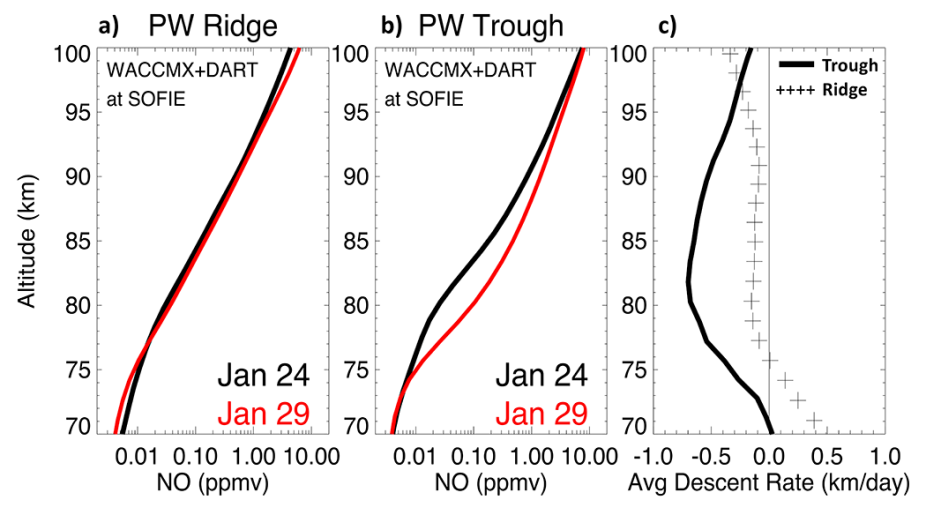Publication: Journal of Geophysical Research - Atmospheres; First HAO Author: Nick Pedatella; Authors as listed in article: V. L. Harvey, S. Datta-Barua, N. Wang, N. M. Pedatella, C. E. Randall, D. E. Siskind, and W. E. Van Caspel
The energetic particle precipitation (EPP) indirect effect (IE) refers to the downward transport of reactive odd nitrogen (NOx=NO+NO2) produced by EPP (EPP-NOx) from the polar winter mesosphere and lower thermosphere to the stratosphere where it can destroy ozone. Previous studies of the EPP IE examined NOx descent averaged over the polar region, but the work presented here considers longitudinal variations. We report that the January 2009 split Arctic vortex in the stratosphere left an imprint on the distribution of NO near the mesopause, and that the magnitude of EPP-NOx descent in the upper mesosphere depends strongly on planetary wave phase.

Daily average WACCMX+DART NO profiles on 24 January (black) and 29 January(red) at the SOFIE measurement latitudes and located in the planetary wave (PW) a) ridge and b) trough. Panel c) gives vertical profiles of effective descent rates in the ridge (plus signs) and trough (solid line) of the planetary wave. The results demonstrate that there is greater downward transport of NO within the planetary wave trough compared to the planetary wave ridge, indicating that the downward transport of NO from the mesosphere to the stratosphere is not longitudinally uniform.
We focus on a 13-day case study immediately following the 2009 sudden stratospheric warming (SSW) during which regional-scale Lagrangian Coherent Structures (LCSs) formed atop the strengthening mesospheric vortex. The LCSs emerged over the north Atlantic in the vicinity of the trough of a 10-day westward traveling planetary wave. Over the next week the LCSs acted to confine elevated NO to high latitudes in polar darkness, effectively prolonging its lifetime as it descended into the top of the polar vortex. Both a whole atmosphere data assimilation model and satellite observations show that the planetary wave trough remained coincident in space and time with elevated NO as both migrated west over the Canadian Arctic. Estimates of descent rates indicate 5 times stronger descent inside the planetary wave trough compared to other longitudes. This case serves to set the stage for future climatological analysis of NO transport via LCSs.